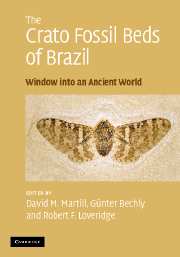Book contents
- Frontmatter
- Contents
- Contributors
- Preface
- Acknowledgements
- Part I The Crato Formation Konservat Lagerstätte
- Part II The invertebrate fauna
- Part III The vertebrate fauna
- 12 The Crato Formation fish fauna
- 13 Anurans of the Crato Formation
- 14 Turtles of the Crato Formation
- 15 Lizards of the Crato Formation
- 16 Crocodilians of the Crato Formation: evidence for enigmatic species
- 17 Pterosaurs of the Crato Formation
- 18 Birds of the Crato Formation
- Part IV The flora
- Part V Miscellanea
- Appendix: species list for the Crato Formation
- Systematic index
- Plate section
- References
15 - Lizards of the Crato Formation
Published online by Cambridge University Press: 22 August 2009
- Frontmatter
- Contents
- Contributors
- Preface
- Acknowledgements
- Part I The Crato Formation Konservat Lagerstätte
- Part II The invertebrate fauna
- Part III The vertebrate fauna
- 12 The Crato Formation fish fauna
- 13 Anurans of the Crato Formation
- 14 Turtles of the Crato Formation
- 15 Lizards of the Crato Formation
- 16 Crocodilians of the Crato Formation: evidence for enigmatic species
- 17 Pterosaurs of the Crato Formation
- 18 Birds of the Crato Formation
- Part IV The flora
- Part V Miscellanea
- Appendix: species list for the Crato Formation
- Systematic index
- Plate section
- References
Summary
Lizards, in the general sense of limbed Squamata, include iguanas, geckos, monitors, extinct mosasaurs, skinks and a wide number of other groups of usually long-tailed, sprawling-limbed diapsid reptiles. Snakes are also included within the Squamata as they are more closely related to lizards than to any other group of reptiles. As with most of the Crato palaeobiota, lizards appear to come only from the Nova Olinda Member laminated limestones of the Nova Olinda–Santana do Cariri region. Their remains are extremely rare and the described forms are of terrestrial groups, suggesting that the occurrences are largely allochthonous. The Crato Formation lizards are among the oldest known in South America (Candeiro, 2007) but, because of their rarity, any assessment of Crato lizard diversity is premature. Both described specimens appear to represent basal forms (Evans and Yabumoto, 1998; Bonfim, 2002).
In a number of specimens there is evidence of soft-tissue preservation, although the skeletons are not necessarily complete. They are usually articulated, but specimens may be missing distal regions of the tail (perhaps due to autotomy) and/or missing limbs. Perhaps such specimens, missing significant components of the skeleton, but otherwise well preserved, represent individuals dropped by volant predators.
Systematic palaeontology
Reptilia
Lepidosauria Heackel, 1866
Squamata, Oppel, 1811
Incertae sedis
Incertae sedis Olindalacerta Evans and Yabumoto, 1998
Olindalacerta brasiliensis Evans and Yabumoto, 1998
This taxon is based on a single, certainly juvenile specimen, housed in the Kita- kyushu Museum of Natural History & Human History in Japan, number KMNH VP 400,001, and comprises both the part and counterpart slabs (Figures 15.1a and b and 15.2).
- Type
- Chapter
- Information
- The Crato Fossil Beds of BrazilWindow into an Ancient World, pp. 458 - 462Publisher: Cambridge University PressPrint publication year: 2007
References
- 2
- Cited by



